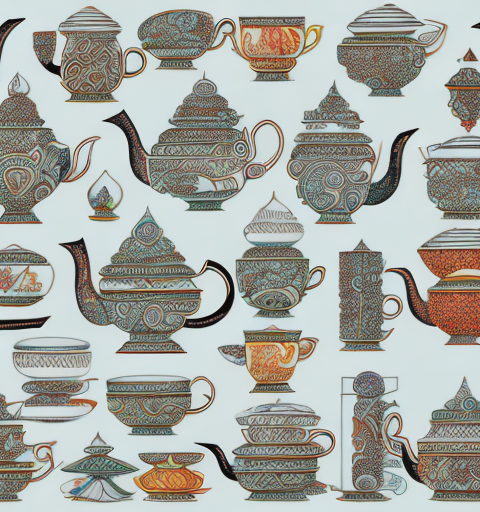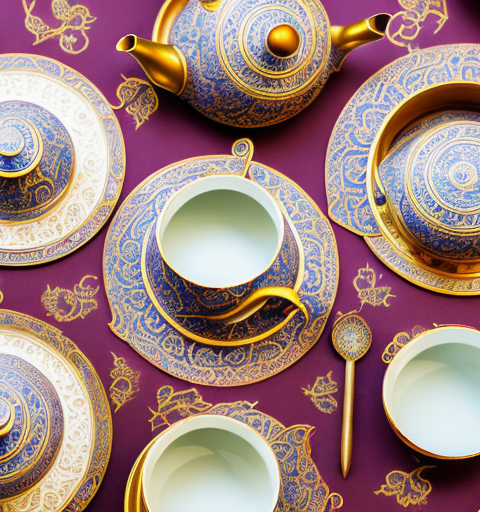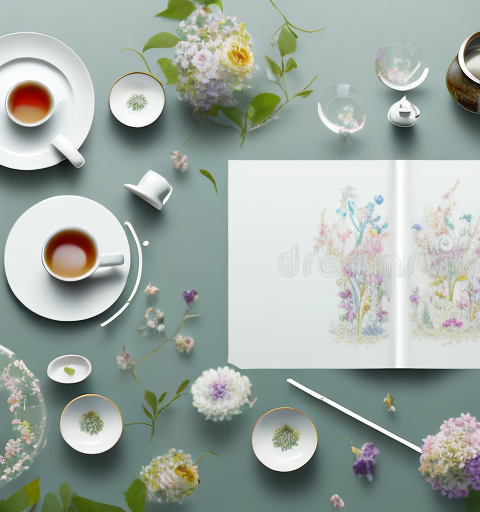Are you a tea enthusiast who has fallen in love with the beauty and charm of vintage teapots made in Japan? If so, you’re not alone. These unique teapots have a timeless allure that captivates collectors and tea lovers around the world. In this comprehensive guide, we will explore the history of Japanese teapot making, delve into the distinguishing features of authentic vintage teapots, provide tips on starting your own collection, and offer advice on caring for and enjoying your cherished teapots.
Understanding the Allure of Vintage Japanese Teapots
Before we dive into the details, let’s take a moment to appreciate the irresistible appeal of vintage teapots from Japan. These exquisite pieces of craftsmanship blend artistry and functionality in a way that is unmatched by mass-produced teapots. The allure lies in their rich history, unique characteristics, and the intrinsic value they hold for collectors.
The History of Teapot Making in Japan
Japanese teapot making dates back centuries and is deeply rooted in the country’s tea culture. The art of crafting teapots was initially influenced by Chinese artisans but evolved into a distinct Japanese style known for its simplicity, elegance, and harmony with nature. Each teapot tells a story, bridging the gap between past and present.
During the Edo period (1603-1868), Japan experienced a flourishing tea culture, and teapot making became a revered art form. Skilled craftsmen honed their techniques, passing down their knowledge from generation to generation. The teapots produced during this time reflected the aesthetics of the tea ceremony, with emphasis placed on balance, harmony, and the appreciation of imperfections.
One of the most famous styles of Japanese teapots is the Banko-yaki teapot. Originating from the Mie Prefecture, these teapots are made from a unique red clay that is rich in iron. Banko-yaki teapots are known for their ability to retain heat and enhance the flavor of the tea. The clay used in their production undergoes a meticulous process of refinement and firing, resulting in a teapot that is both functional and visually striking.
Unique Characteristics of Japanese Teapots
What sets vintage Japanese teapots apart from their counterparts is the meticulous attention to detail and the use of traditional materials like clay, porcelain, and cast iron. The forms range from simple and understated to elaborate and ornate, and their beauty lies in the delicate balance between aesthetics and functionality.
Japanese teapots often feature intricate hand-painted designs, depicting scenes from nature, traditional motifs, or calligraphy. These designs not only add visual appeal but also serve as a reflection of the artist’s skill and creativity. The use of natural materials and traditional firing techniques gives each teapot a unique character, with subtle variations in color, texture, and glaze.
Another fascinating aspect of vintage Japanese teapots is their connection to tea masters and renowned potters. Some teapots bear the signatures or seals of famous artisans, adding to their historical value and desirability among collectors. Owning a teapot crafted by a renowned potter is like owning a piece of art that carries the spirit and legacy of its creator.
Furthermore, vintage Japanese teapots are not only admired for their aesthetic appeal but also for their functionality. The design of the spout, handle, and lid ensures a smooth and controlled pour, allowing the tea to be brewed and served with precision. The materials used in their construction, such as clay or cast iron, contribute to the heat retention properties, ensuring that the tea stays warm for longer periods.
In conclusion, vintage Japanese teapots possess a captivating allure that stems from their rich history, unique characteristics, and the artistry involved in their creation. These teapots are not just vessels for brewing tea; they are cultural artifacts that embody the essence of Japanese tea culture and the skill of the craftsmen who brought them to life.
Identifying Authentic Vintage Japanese Teapots
With the increasing popularity of vintage teapot collecting, it is crucial to know how to authenticate these treasured pieces. Here are some key features to look for when identifying authentic vintage Japanese teapots:
Key Features to Look For
To determine the authenticity of a vintage Japanese teapot, examine its shape, material, glaze, and craftsmanship. Look for subtle imperfections that are indicative of handcrafted teapots. Authentic vintage Japanese teapots often have unique shapes that reflect the traditional Japanese tea ceremony. These shapes can vary from the classic round form to more intricate designs inspired by nature, such as bamboo or cherry blossoms.
The material of the teapot is also an important factor to consider. Traditional Japanese teapots are typically made from clay or porcelain. Clay teapots, such as those made from Tokoname clay, are highly valued for their ability to enhance the flavor of the tea. Porcelain teapots, on the other hand, are known for their delicate beauty and intricate designs.
When examining the glaze of a vintage Japanese teapot, look for a smooth and even finish. Authentic teapots often have a rich, glossy glaze that is carefully applied by skilled artisans. The glaze should not have any cracks or bubbles, as these can be signs of a replica or a poorly made teapot.
Craftsmanship is another important aspect to consider when identifying authentic vintage Japanese teapots. Look for intricate details and fine craftsmanship, such as hand-painted designs or intricate carvings. These details are often a testament to the skill and artistry of the teapot maker.
Pay attention to the markings and signatures on the teapot, as they can provide valuable information about its origin and maker. Some vintage Japanese teapots may have the maker’s signature or a stamp indicating the teapot’s authenticity. Familiarize yourself with the common markings and signatures of renowned Japanese teapot makers, such as Tokoname, Banko, and Kutani, to enhance your knowledge and recognition of authentic teapots.
Common Makers and Marks
Some renowned Japanese teapot makers include Tokoname, Banko, and Kutani. These makers have a long history of producing high-quality teapots that are highly sought after by collectors. Each maker has their own distinctive marks and signatures that can help you identify the authenticity of a teapot.
Tokoname teapots, for example, are known for their reddish-brown clay and simple yet elegant designs. They often have a signature mark on the bottom of the teapot, indicating the maker’s name or the kiln where it was produced. Banko teapots, on the other hand, are made from a unique purple clay and are known for their intricate carvings and detailed craftsmanship. These teapots may have a stamp or a signature mark on the side or bottom of the teapot.
Kutani teapots are recognized for their vibrant colors and elaborate hand-painted designs. They often feature intricate patterns and motifs, such as flowers, birds, or landscapes. Look for the Kutani mark on the teapot, which typically consists of the word “Kutani” written in kanji characters.
Remember, research is key when it comes to building a collection of true vintage pieces. Take the time to educate yourself on the different makers, marks, and styles of vintage Japanese teapots. By familiarizing yourself with these details, you can confidently identify and appreciate the authenticity and beauty of these treasured pieces.
How to Start Your Vintage Teapot Collection
Now that you’re familiar with the allure of vintage Japanese teapots and how to identify authentic ones, it’s time to consider how to start your own collection.
Starting a vintage teapot collection is an exciting journey that allows you to explore the rich history and craftsmanship of these beautiful pieces. Whether you’re a tea enthusiast or simply appreciate the elegance of vintage collectibles, building a collection of vintage Japanese teapots can be a rewarding and fulfilling experience.
One of the first steps in starting your collection is to determine where to find these treasures. Antique stores, flea markets, and online marketplaces are great places to begin your hunt for vintage Japanese teapots. These places often have a wide selection of teapots from different eras, giving you the opportunity to discover unique and rare pieces.
When visiting antique stores and flea markets, take your time to explore different stalls and vendors. Engage in conversations with the sellers, as they may have valuable insights or stories about the teapots they have on display. Building connections with fellow collectors can also be beneficial, as they can guide you in your pursuit and share their knowledge and experiences.
Online marketplaces, such as auction websites or dedicated vintage collectible platforms, offer convenience and a vast array of options. Take advantage of search filters to narrow down your options and find teapots that match your preferences. However, when purchasing online, it’s important to be cautious and verify the authenticity and condition of the teapot before making a purchase.
Tips for Evaluating Quality and Authenticity
When purchasing vintage teapots, it’s crucial to examine them closely to ensure their quality and authenticity. Here are some tips to help you in your evaluation:
- Inspect for damages: Carefully examine the teapot for any damages, cracks, or chips. These imperfections can significantly affect the value and overall appeal of the teapot.
- Look for repairs: Check if the teapot has undergone any repairs. While minor repairs may not necessarily diminish its value, extensive or poorly executed repairs can impact its authenticity and collectability.
- Observe the craftsmanship: Pay attention to the details and craftsmanship of the teapot. Vintage Japanese teapots are known for their intricate designs and meticulous craftsmanship. Look for fine details, such as hand-painted motifs or delicate engravings, which indicate the skill and artistry involved in creating the teapot.
- Research the maker: If possible, research the maker or brand of the teapot. Certain makers or brands have a reputation for producing high-quality teapots, which can increase their value and desirability among collectors.
- Seek expert advice: If you’re unsure about the authenticity or value of a teapot, don’t hesitate to ask questions or seek the assistance of experts. Antique dealers, appraisers, or experienced collectors can provide valuable insights and help you make informed decisions.
By following these tips and being diligent in your evaluation, you can ensure that the teapots you add to your collection are of excellent quality and hold historical significance.
Caring for Your Vintage Teapot Collection
Preservation is key when it comes to maintaining the beauty and value of your vintage teapot collection. Here are some essential tips on caring for your treasured teapots:
Teapots, with their intricate designs and delicate materials, require special care to ensure their longevity. By following these cleaning and maintenance tips, as well as proper storage techniques, you can enjoy your vintage teapot collection for years to come.
Cleaning and Maintenance Tips
Gently hand wash your teapots using mild soap and warm water. This will help remove any dirt or residue that may have accumulated over time. Avoid using abrasive materials or harsh chemicals that can damage the delicate surface of the teapots. Instead, opt for soft sponges or brushes to gently clean the nooks and crannies of the teapot.
After washing, it is crucial to dry the teapots thoroughly to prevent any moisture from causing damage. Use a soft, lint-free cloth to carefully dry the teapots, ensuring that all areas are completely dry. Leaving any moisture behind can lead to the growth of mold or the development of rust, which can be detrimental to the teapots’ condition.
Once the teapots are clean and dry, it is essential to store them in a safe and dust-free environment. Consider using individual display cases or soft cloth bags to protect them from any potential damage. These storage solutions not only shield the teapots from dust and dirt but also provide a buffer against accidental bumps or knocks.
Proper Storage for Longevity
Investing in protective storage solutions is a wise choice to prevent damage and preserve the longevity of your vintage teapot collection. Soft cloth bags, made from non-abrasive materials, provide an extra layer of protection against scratches and dust. These bags are available in various sizes, allowing you to choose the perfect fit for each teapot.
If you prefer a more elaborate display, individual display cases can be an excellent option. These cases are specifically designed to showcase your teapots while keeping them safe from accidental damage. Display cases often feature cushioned interiors and secure closures to ensure that the teapots remain in pristine condition.
In addition to proper storage solutions, it is crucial to be mindful of the temperature and humidity levels in the area where you store your teapots. Extreme conditions, such as high humidity or drastic temperature fluctuations, can be detrimental to the teapots’ materials. To maintain optimal conditions, consider storing your teapots in a cool, dry place away from direct sunlight and sources of heat.
By following these cleaning and maintenance tips, as well as investing in proper storage solutions, you can ensure that your vintage teapot collection remains in excellent condition. Remember, the care and attention you give to your teapots today will preserve their beauty and value for future generations to enjoy.
Enjoying Your Vintage Teapot Collection
Finally, let’s explore the joy of incorporating your vintage teapots into your daily life and embracing the rich tea traditions they symbolize.
Imagine waking up to the gentle aroma of freshly brewed tea, the warm rays of the morning sun casting a soft glow on your vintage teapot collection. As you step into your kitchen, you can’t help but feel a sense of excitement. Today, you will embark on a journey that connects you with history, culture, and the enduring beauty of traditional craftsmanship.
The Art of Japanese Tea Ceremony
With a collection of authentic vintage Japanese teapots, you can embark on the art of the Japanese tea ceremony. This centuries-old practice celebrates mindfulness, tranquility, and the beauty of sharing tea. Picture yourself gracefully pouring tea from a delicate teapot into exquisite teacups, the sound of water gently cascading, creating a soothing melody. Embrace the rituals and immerse yourself in the serene world of tea.
As you prepare for the tea ceremony, you carefully select the perfect teapot, its intricate patterns and delicate colors reflecting the craftsmanship of artisans from long ago. Each teapot tells a story, a testament to the skill and dedication of those who created it. You can’t help but feel a sense of reverence as you hold the teapot in your hands, knowing that it has witnessed countless tea ceremonies throughout its lifetime.
Incorporating Vintage Teapots into Your Home Decor
Aside from the traditional tea ceremony, vintage Japanese teapots can add a touch of elegance to your home decor. Display them on shelves, in glass cabinets, or create a dedicated tea corner where you can enjoy the harmony between old and new. Picture a cozy reading nook, adorned with plush cushions and a small table adorned with your teapot collection. As you curl up with a book, the presence of these vintage treasures creates an atmosphere of tranquility and sophistication.
Imagine inviting friends over for a tea party, the table adorned with a beautiful vintage teapot as the centerpiece. As you pour tea for your guests, you share stories of the teapots’ origins, the history behind each piece. The teapots become not just vessels for tea, but conversation starters, connecting people through shared appreciation for art and culture.
Collecting and enjoying vintage teapots made in Japan is a journey that goes beyond mere acquisition. It is a journey that connects you with the past, allowing you to appreciate the artistry and craftsmanship of a bygone era. By understanding their allure, identifying authentic pieces, caring for your collection, and embracing the joy they bring, you can embark on a lifelong appreciation of these exquisite treasures.
So, as you continue to explore the world of vintage teapots, remember to savor each moment, to relish the stories they hold, and to find delight in the simple act of brewing a cup of tea. Your collection is not just a display of beautiful objects; it is a gateway to a world of culture, history, and the timeless elegance of tea.






